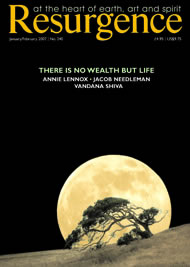IN THE RECENT Inter-national Futures Forum trip to New Delhi, a group of us were able to sit on Shakti Maira’s terrace and discuss some of the important ideas in his new book Towards Ananda. Ananda is the Sanskrit word for joy or bliss, and is central to Shakti’s understanding of the experience of beauty.
He explained his unusual dual career, having qualified as an MBA and carried out projects for the World Bank. He therefore knows that there is more to wellbeing than a well-paid job and a Mercedes Benz. In the last fifteen years he has become a full-time artist and sculptor as well as a writer on art and aesthetics. His first-hand experience of economic and cultural globalisation, along with his rootedness in traditional Indian philosophy, gives him a significant vantage point from which to view current developments in art.
Shakti explains that the Indian word for philosophy is darshan, which means ‘seeing’, and is hence connected to vision. The development of vision is essential for both the true philosopher and the artist, given that the underlying purpose of both art and philosophy in India is not so much knowledge as transformation. The two key ideas in Indian aesthetics are chhandomaya and ananda. Chhandomaya is the ‘rhythm, balance, proportion and harmony that are the essence of all nature and life’. Then he explains that the movement of the human spirit towards ananda is the central purpose of all art and philosophy, and that the highest spiritual state is one that combines being, consciousness and bliss. So in this context the principal purpose of art is the transformation of the viewer by inducing a ‘state of transcendence and deepening’.
Contrast this with the dominance of mental and conceptual art in the West, leading to ‘installations’ that do not even require the artist to be able to draw. Shakti criticises the notion of art for art’s sake, insisting that art is about connection and communication, not simply self-expression. He suggests that many of these installations – such as tampon chandeliers – are little better than rants and ravings, and should be classified as such: that “we should stop the charade about such displays being called and considered art, and reclaim art from the elite – and bring it back into the real world in which most of us live.”
In a section entitled ‘The new and the eternal’, Shakti discusses the meaning of originality. In Indian culture it meant ‘coming from its source within, like water from a spring’. However, in the West, the terms ‘new’ and ‘original’ have become synonymous; “hence novelty is mistaken for originality”. Shakti quite rightly comments that the trend towards newness is basically the drive of marketing and selling.
Instead, Shakti proposes revitalising the art of joy that reconnects us with beauty. When we experience beauty, “We become connected with the
harmony, balance, rhythm and proportion that is everywhere: in nature, in music, in art and within us. It is this experience that we find pleasurable and when it is deep and integrated, it results in joy, bliss, ananda.”
The quotation points to the heart of the book, which is the contention that these aesthetic values should be more widely applied to areas of life outside art. In addition to the four mentioned above, Shakti adds vitality and beauty itself. It is in this sense that one can understand his suggestion that the Indian government should declare a National Aesthetic Emergency (why not global?). Shakti explains how aesthetic values can be applied in everything we do: “We need greater harmony between people and with nature; we need greater balance and proportionality in the distribution of power, money, jobs, rights, responsibilities and duties. We need the rhythm of efficiency, peace and cleanliness, and we need the vitality of health, freedom and fearlessness.” Needless to say, these principles can be applied to education. Shakti notes that the recent Indian curriculum review includes intelligence, emotional and spiritual quotients (IQ, EQ, SQ) so he asks why they did not think it necessary to have an aesthetic quotient (AQ) as well.
Towards the end of the book Shakti makes a link between aesthetics and globalising economics with his powerful parable of the mangoes lost to the wholesaler: they no longer ripen on the tree but artificially, so children lose the delectable ananda of tasting a fresh mango; also its beauty. Such is the power of the global economy that this small wholesaler cannot afford to ripen his mangoes in the traditional way. And when these mangoes reach the consumer, they are likely by then still to be slightly unripe or even prematurely rotten. It is a victory of quantity over quality, economics over ecology, greed over beauty. The rise in profits is paid for through an impoverishment of the human spirit.
We need to give serious thought to the best means of balancing the advantages of increasing global prosperity with the aesthetic values outlined in this book. In the end, we will surely find that our inner needs are more crucial than our outer desires. Back on the terrace there is a sense of peace and presence both in the human beings and in the art – for finally outer beauty can be matched by inner beauty.
David Lorimer is Programme Director of The Scientific and Medical Network.







